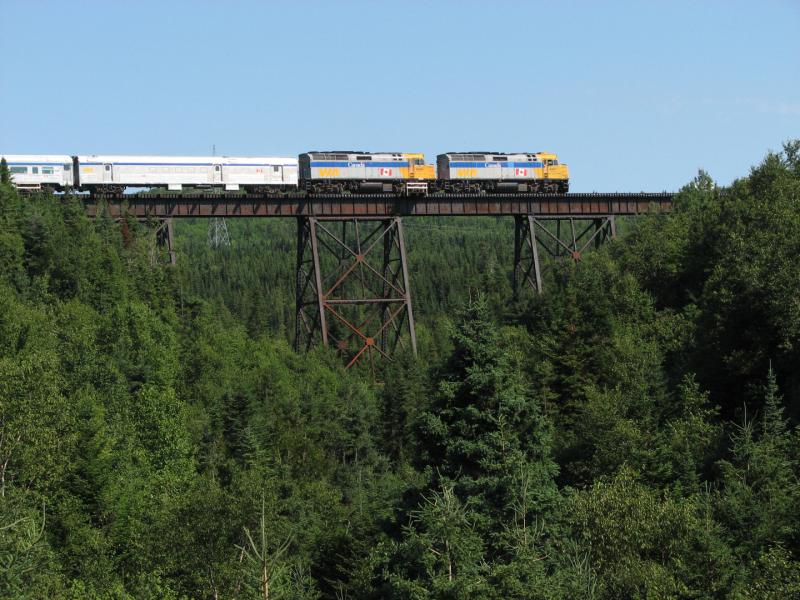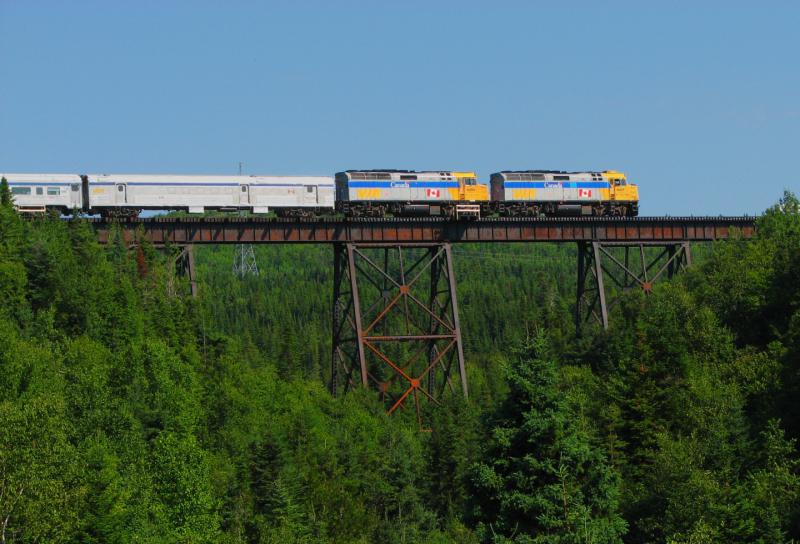In the film age, post-processing was done in the darkroom with selective dodging and burning and other techniques. I don't know a lot about the film techniques because I've never developed my own photos.
In the digital age, post-processing begins when you open the digital file (hopefully in RAW format) in your favourite editor. For me it's either Canon's Digital Photo Professional or Paint.NET. Cropping, changing exposure, sharpening, saturation... there are so many ways you can change a photo. One could wonder at what point a photograph ceases to be a photograph and is instead a digital construct.
Here's a case in point. I started a photo theme on Google+ for bridges. I looked for a bridge photo of my own and decided on the Chaleur crossing the trestle near Gascon, Quebec. This is the original image. The only processing done to this is to resize it.

Now this is a heavily reprocessed version of the same image.

You can see I cropped it a bit. I used Paint.NET and ended up with four layers:
- foreground and bridge and portion of engines
- train cars
- yellow on engines
- sky
Just for comparison... I blogged about my Chaleur chase with David Morris back in 2007. At that time, I posted this photo. It's not the same image but only a few seconds later than the above image. I don't remember the processing but I'm sure I cropped a bit, maybe tweaked the brightness and/or contrast, and resized it.
What do you think? Do you prefer the original, or the heavily reprocessed version? Are the changes too much? Does it still look realistic? I'm very curious to hear what you think of this particular image, and image manipulation in general.
4 comments:
Hi Steve,
Very good point you bring up in regard to the post processing of digital images. Just when does a photograph cease to be a photograph and become a digital reconstruct ? I've wrestled with that same issue for awhile now, since I started taking pictures with digital cameras. Don't get me wrong I love my Nikon D7000 very much. It's one heck of a camera, no regrets.
When one chooses to "alter" an image in the post processing mode, doesn't that effectively make it another photo or image ? It's certainly not the one you took at the time.
What then...does that say about one's initial photo taking abilities ?
I liken that concept to, say, writing a test with your knowledge at the time, and then after the test is corrected, having the ability to re correct wrong answers ! What does that say about one's on board ability to take excellent photos at the time, given what ever one has for a camera.
To me ...that is the ultimate test and the "showing off" , if you like, of ones ability to be a photographer. No ??
Anyone can take a so-so image and re process the hell out of it, to make it something, that...in my opinion should have been done in the first instance.
All your doing there is showing your astuteness at working a computer program, not working a camera.
As far as your train bridge photos go..... they are all good images, but personally I would say you over saturated the second one...the forest or trees look too green , and in doing so..it appears that some detail is lost when I study the trees from both photos.
I like the first one best.
The ultimate test is to be able to produce a photo with your camera that comes as close as to what your eyes see at the time the photo was taken. No post processing.
I'll step off my soap box now. Sermons over.
But as always Steve...keep the camera clicking, and the post processing down to a minimum.
Cheers,
Glen
Thanks for your well-thought-out comment, Glen. I find as I take more photos that I am willing to spend more time and effort in post processing. I used to accept whatever came out of the camera pretty much "as is", but I've come to realize that one can take a mediocre photo and turn it into a good one with a little processing.
I do aim to shoot a good photo "in the camera". Post processing takes time and there is no substitute for doing everything right when you click the shutter release. That's why I use circular polarizers and I intend to use other filters, to do it "in camera". But sometimes you can do more with processing.
I have a few personal rules with post processing. I can take out minor objects like a pole or a sign that's in the way, but I won't add something that wasn't there. No rainbows or unicorns or FP9s get added. I won't move stuff around. Everything that is in the photo you see was in the same relative position.
I agree with you, the second photo is a bit oversaturated. I do like the "pop" of the green but it is too much.
Oh, here's a good article I found today on just the thing I was talking about.
Sleight of hand? Deception? Artistic license?
Steve............ I read that article from the link.
Yes..a lot of sound reasoning for post processing..and I agree 100% with 95% of what he says......looks like a good blog he has.
in the end, it's all on what you see and what you you think you want us to "see"..
But , ...it all comes down to this in my books.....
"a mediocore image is better than no image at all.........".
Cheers,
Glen
Sanford, Manitoba
Post a Comment